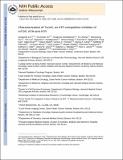Characterization of Torin2, an ATP-Competitive Inhibitor of mTOR, ATM, and ATR
Author(s)
Liu, Qingsong; Xu, Chunxiao; Kirubakaran, Sivapriya; Zhang, Xin; Hur, Wooyoung; Kwiatkowski, Nicholas P.; Wang, Jinhua; Westover, Kenneth D.; Gao, Peng; Ercan, Dalia; Niepel, Mario; Thoreen, Carson C.; Kang, Seong A.; Patricelli, Matthew P.; Wang, Yuchuan; Tupper, Tanya; Altabef, Abigail; Kawamura, Hidemasa; Held, Kathryn D.; Chou, Danny M.; Elledge, Stephen J.; Janne, Pasi A.; Wong, Kwok-Kin; Gray, Nathanael S.; Sabatini, David; Liu, Yan; ... Show more Show less
DownloadSabatini_Characterization of.pdf (3.732Mb)
OPEN_ACCESS_POLICY
Open Access Policy
Creative Commons Attribution-Noncommercial-Share Alike
Terms of use
Metadata
Show full item recordAbstract
mTOR is a highly conserved serine/threonine protein kinase that serves as a central regulator of cell growth, survival, and autophagy. Deregulation of the PI3K/Akt/mTOR signaling pathway occurs commonly in cancer and numerous inhibitors targeting the ATP-binding site of these kinases are currently undergoing clinical evaluation. Here, we report the characterization of Torin2, a second-generation ATP-competitive inhibitor that is potent and selective for mTOR with a superior pharmacokinetic profile to previous inhibitors. Torin2 inhibited mTORC1-dependent T389 phosphorylation on S6K (RPS6KB1) with an EC[subscript 50] of 250 pmol/L with approximately 800-fold selectivity for cellular mTOR versus phosphoinositide 3-kinase (PI3K). Torin2 also exhibited potent biochemical and cellular activity against phosphatidylinositol-3 kinase–like kinase (PIKK) family kinases including ATM (EC[subscript 50], 28 nmol/L), ATR (EC[subscript 50], 35 nmol/L), and DNA-PK (EC[subscript 50], 118 nmol/L; PRKDC), the inhibition of which sensitized cells to Irradiation. Similar to the earlier generation compound Torin1 and in contrast to other reported mTOR inhibitors, Torin2 inhibited mTOR kinase and mTORC1 signaling activities in a sustained manner suggestive of a slow dissociation from the kinase. Cancer cell treatment with Torin2 for 24 hours resulted in a prolonged block in negative feedback and consequent T308 phosphorylation on Akt. These effects were associated with strong growth inhibition in vitro. Single-agent treatment with Torin2 in vivo did not yield significant efficacy against KRAS-driven lung tumors, but the combination of Torin2 with mitogen-activated protein/extracellular signal–regulated kinase (MEK) inhibitor AZD6244 yielded a significant growth inhibition. Taken together, our findings establish Torin2 as a strong candidate for clinical evaluation in a broad number of oncologic settings where mTOR signaling has a pathogenic role.
Date issued
2013-02Department
Massachusetts Institute of Technology. Department of Biology; Whitehead Institute for Biomedical Research; Koch Institute for Integrative Cancer Research at MITJournal
Cancer Research
Publisher
American Association for Cancer Research
Citation
Liu, Q., C. Xu, S. Kirubakaran, X. Zhang, W. Hur, Y. Liu, N. P. Kwiatkowski, et al. “Characterization of Torin2, an ATP-Competitive Inhibitor of mTOR, ATM, and ATR.” Cancer Research 73, no. 8 (February 22, 2013): 2574–2586.
Version: Author's final manuscript
ISSN
0008-5472
1538-7445